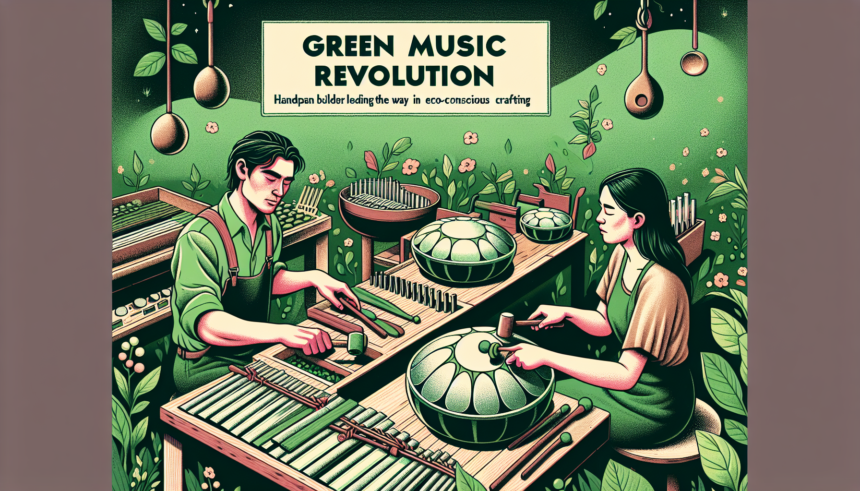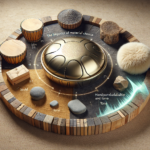Music has always been a universal language, connecting people across cultures and generations. However, in the wake of growing climate concerns, the music industry, like many others, is under pressure to adopt more sustainable practices. Among the leaders in this green revolution are handpan builders, who are pioneering eco-conscious crafting techniques that promise to harmonize our love for music with our need to protect the environment.
The Origins of the Handpan
The handpan, a captivating steel percussion instrument, first emerged in the early 2000s. Its ethereal sound and mesmerizing aesthetics quickly earned it a dedicated following. Originally inspired by traditional instruments like the steel drum and the Caribbean Hang, the handpan has become a symbol of innovative craftsmanship. Now, builders are taking this innovation a step further by focusing on sustainability.
Eco-Friendly Materials
One of the primary ways handpan builders are contributing to a greener world is by sourcing eco-friendly materials. Traditional handpans are made from high-quality steel, but this material has a significant carbon footprint due to its production process. Innovative builders are exploring alternatives like recycled steel, which reduces the environmental impact without compromising on sound quality.
Additionally, some builders are experimenting with alternative metals and hybrid materials. For example, using natural composites that blend organic fibers with metal alloys can create instruments that are not only lightweight but also more sustainable.
Sustainable Manufacturing Processes
Beyond the materials, the manufacturing process itself is a key area for greening the music industry. Traditional metalworking often involves energy-intensive processes and hazardous chemicals. In contrast, eco-conscious handpan builders are turning to sustainable techniques. This includes using renewable energy sources like solar power to run their workshops and adopting water-based, non-toxic chemicals for treating and finishing the instruments.
Another innovative approach is the use of closed-loop systems, where waste from the production process is recycled back into the system. This minimizes waste and conserves resources, ensuring that the environment is impacted as little as possible by the crafting of these beautiful instruments.
Community and Education
The green music revolution is also a community effort. Handpan builders who prioritize sustainability are often involved in educating others about eco-friendly practices. Workshops, seminars, and online resources help musicians and fellow builders understand the importance of environmentally responsible crafting. By sharing their knowledge and experiences, these pioneers foster a community that values sustainability and seeks to make a positive impact.
Many builders also support reforestation projects and other environmental initiatives. For instance, some have partnered with organizations that plant a tree for every handpan sold. This kind of commitment not only offsets the carbon footprint of the instrument but also helps promote broader environmental awareness.
The Role of Technology
Technology plays a significant role in the eco-conscious crafting of handpans. Advances in digital modeling and 3D printing enable builders to design and prototype new instruments with greater precision and less waste. These technologies allow experimentation with shapes, sizes, and materials that would be too costly or time-consuming with traditional methods.
Additionally, digital platforms facilitate global collaboration, enabling builders to share techniques and materials more efficiently. Crowdsourcing ideas and sourcing sustainable materials from around the world becomes much more feasible, enhancing the collective effort towards more sustainable crafting practices.
Challenges and Opportunities
Despite the many advancements, the path to truly sustainable handpan crafting is not without challenges. The primary obstacle is the availability and cost of eco-friendly materials. Sustainable metals are often more expensive, and the market for these materials can be inconsistent. Additionally, there is a learning curve associated with new manufacturing techniques, which requires both time and investment.
However, these challenges also present significant opportunities. As demand for eco-friendly instruments grows, it drives innovation and pushes the industry to find creative solutions. Early adopters of green practices often set themselves apart in the market, attracting environmentally conscious consumers and setting trends that others will eventually follow.
The Future of Handpan Crafting
Looking ahead, the future of handpan crafting appears bright and green. Continued research into sustainable materials and methods promises to further reduce the environmental impact of these instruments. As technology advances, we can expect even more efficient and eco-friendly manufacturing processes.
The growing awareness of environmental issues among consumers will likely drive further demand for sustainably crafted handpans. This trend is not limited to handpans alone but is part of a larger movement within the music industry towards sustainable practices. As such, handpan builders will continue to play a pivotal role in shaping this green music revolution.
Conclusion
In conclusion, handpan builders are at the forefront of the green music revolution, leading the way with eco-conscious crafting practices. By sourcing sustainable materials, adopting innovative manufacturing techniques, and fostering a community dedicated to environmental stewardship, these artisans are setting a powerful example for the entire music industry. The challenges are significant, but so are the opportunities, and the commitment to sustainability promises a harmonious future where beautiful music and environmental responsibility go hand in hand.
FAQs
- 1. What is a handpan?
- A handpan is a steel percussion instrument known for its ethereal sound and captivating aesthetic. It is a relatively new instrument, emerging in the early 2000s, and has roots in traditional instruments like the steel drum and the Caribbean Hang.
- 2. How are handpan builders making their craft more eco-friendly?
- Handpan builders are adopting eco-friendly practices by sourcing sustainable and recycled materials, using renewable energy sources in their workshops, employing non-toxic chemicals, and implementing closed-loop systems that minimize waste.
- 3. What role does technology play in sustainable handpan crafting?
- Technology facilitates sustainable handpan crafting by enabling precise digital modeling and 3D printing, which reduce waste. It also allows for global collaboration and efficient sourcing of sustainable materials, helping builders innovate more effectively.
- 4. What are the main challenges in eco-conscious handpan crafting?
- The primary challenges include the availability and cost of sustainable materials, the need for investment in new manufacturing techniques, and the learning curve associated with these methods. Overcoming these hurdles requires creativity and commitment from builders.
- 5. How can consumers support sustainable handpan crafting?
- Consumers can support sustainable handpan crafting by choosing to buy from builders who prioritize eco-friendly practices, participating in community education efforts, and promoting awareness about the importance of sustainability in the music industry.





